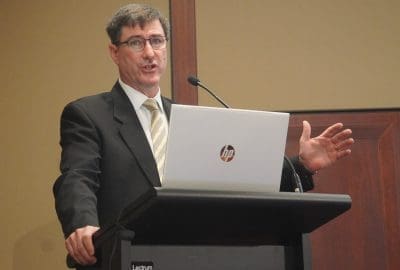
Carbon and alternate energy projects are showing signs of becoming a ‘new coal seam gas’ in terms of influencing rural property values, a Brisbane industry audience heard this morning.
The topic arose during questiontime at valuer, Herron Todd White’s annual property breakfast held simultaneously in Brisbane and Melbourne.
Colliers’ Rawdon Briggs asked whether there was a view within HTW with regard to values for properties with a base line cash-flow from carbon or renewable energy projects, or gas – providing income regardless of commodity price movements.
“One of the influences which continues to drive the property market is the different biases of capital,” HTW’s Tim Lane told the gathering.
“Given the interest in environmental and social governance, carbon space investment and alternate energy, we are increasingly fielding inquiries from people looking for property assets with these features or potential – either for alternative use to traditional agriculture, or simply as diversity of income beyond agriculture production,” he said.
Whether it be solar or windfarms in southern Australia, or energy/carbon projects on big areas such as the Darling Downs, this demand was driving some of the recent land value shifts that have been seen, Mr Lane said.
“They can afford to pay the dollars they can, because of the combined blend of cash flows (from traditional agriculture plus the potential carbon or alternate energy annuity).
“Six or seven years ago, we talked (speculatively) about the future opportunity for buying a goat block, with a solar farm in one corner and a carbon offset project in the other. Here we are in 2022, with projects like the large-scale wind-farm project at Tubbo Station (see earlier report), and the cash flows, when we work those transactions back, are offering very competitive yields that people are prepared to buy those properties for.”

HTW’s Tim Lane addressing this morning’s property breakfast in Brisbane
Mr Lane thought the industry would see a little more of that competition emerge for this type of asset, as opportunities come into the market space.
“On the carbon front, we are seeing between 60 and 80 carbon assessment type jobs across Australia. I know a lot of the banks and our corporate capital clients are interested to better understand that future environment picture. Part of what HTW is building internally is a database which will enable us to capture a lot more of that information (ie income from carbon/alternate energy projects), to better understand those shifting trends, because of lot more of our available capital is looking for those things.”
“In the carbon space, with often get the request from a client to assess an asset either inclusive or exclusive of the cash flow from energy/carbon projects, because investors are trying to understand those different drivers.”
Melbourne-based HTW valuer Graeme Whyte told the gathering that a similar trend was evident in more southerly parts of Australia.
“But the reality is, we haven’t really seen any stand-alone solar farms or wind-farms sell yet. I imagine we will see some come to the market at some point, and that is something that will be driven by the yield, and investors’ perception of the risk associated with it,” he said.
“In recent times, we’ve analysed grazing properties in southern Victoria or Tasmania, for example, where there is half a dozen wind turbines, providing a bit of that annuity style income. But its always hard to know just how much of that overall sale price can be attributed to that additional income stream,” Mr Whyte said.
“We think in those examples its really people buying a farm, which has ‘a bit of wind turbine income on the side’ – but mostly motivated by the farming aspect.”
Tubbo Station in the Riverina was probably the first example where a large-scale grazing property was sold with solar income. The 14,900ha property sold for north of $40 million, with an annual income of $560,000 from a 539ha solar farm.
“It makes it hard to apportion it out, to know what it shows. A lot of buyers would see the solar annuity component as a reliable income stream, and compare it to returns from other commercial assets,” Mr Whyte said.
“But this (alternate energy/carbon projects) is still an immature market, and it is still too early to know how people are going to look at it.”
“The whole renewable energy sector is still such an evolving space, and something that may make sense and look good now, may not be the leading technology in ten years’ time.”
“There’s still a bit of uncertainty, as to when we do start to see some of these alternate energy projects sell, as to what sort of yields they will show.”
- More reports from the HTW breakfast on Monday
